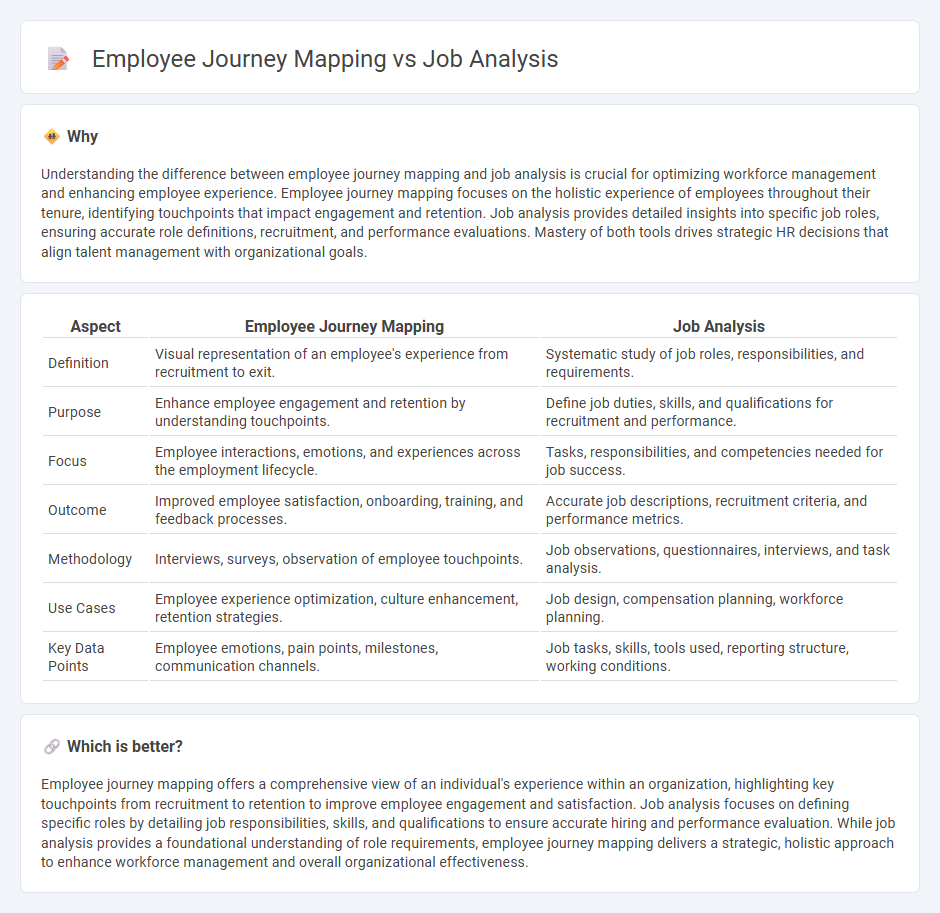
Employee journey mapping captures the comprehensive experience and interactions an employee has within an organization, highlighting key touchpoints and emotional responses. Job analysis focuses on defining specific roles, responsibilities, skills, and qualifications required for effective performance in a position. Explore deeper insights into how these methodologies enhance talent management and organizational development.
Why it is important
Understanding the difference between employee journey mapping and job analysis is crucial for optimizing workforce management and enhancing employee experience. Employee journey mapping focuses on the holistic experience of employees throughout their tenure, identifying touchpoints that impact engagement and retention. Job analysis provides detailed insights into specific job roles, ensuring accurate role definitions, recruitment, and performance evaluations. Mastery of both tools drives strategic HR decisions that align talent management with organizational goals.
Comparison Table
| Aspect | Employee Journey Mapping | Job Analysis |
|---|---|---|
| Definition | Visual representation of an employee's experience from recruitment to exit. | Systematic study of job roles, responsibilities, and requirements. |
| Purpose | Enhance employee engagement and retention by understanding touchpoints. | Define job duties, skills, and qualifications for recruitment and performance. |
| Focus | Employee interactions, emotions, and experiences across the employment lifecycle. | Tasks, responsibilities, and competencies needed for job success. |
| Outcome | Improved employee satisfaction, onboarding, training, and feedback processes. | Accurate job descriptions, recruitment criteria, and performance metrics. |
| Methodology | Interviews, surveys, observation of employee touchpoints. | Job observations, questionnaires, interviews, and task analysis. |
| Use Cases | Employee experience optimization, culture enhancement, retention strategies. | Job design, compensation planning, workforce planning. |
| Key Data Points | Employee emotions, pain points, milestones, communication channels. | Job tasks, skills, tools used, reporting structure, working conditions. |
Which is better?
Employee journey mapping offers a comprehensive view of an individual's experience within an organization, highlighting key touchpoints from recruitment to retention to improve employee engagement and satisfaction. Job analysis focuses on defining specific roles by detailing job responsibilities, skills, and qualifications to ensure accurate hiring and performance evaluation. While job analysis provides a foundational understanding of role requirements, employee journey mapping delivers a strategic, holistic approach to enhance workforce management and overall organizational effectiveness.
Connection
Employee journey mapping and job analysis are connected through their focus on optimizing workforce management and enhancing employee experience. Job analysis provides detailed information about job roles, responsibilities, and required skills, which helps accurately identify key touchpoints and expectations within the employee journey. Integrating job analysis data into employee journey mapping enables HR professionals to align recruitment, onboarding, development, and retention strategies with real job requirements, driving improved performance and satisfaction.
Key Terms
Job Analysis:
Job analysis systematically identifies and documents the specific tasks, responsibilities, skills, and qualifications required for a role, forming the foundation for job descriptions, recruitment, and performance evaluations. It provides detailed insights into job content, work environment, and necessary competencies, enabling effective workforce planning and development. Explore more to understand how job analysis drives strategic HR decisions and optimizes employee productivity.
Job Description
Job analysis systematically identifies the tasks, responsibilities, and skills necessary for a specific role, forming the foundation of an accurate and detailed job description. Employee journey mapping examines the holistic experience of employees throughout their tenure, highlighting touchpoints that influence engagement and retention but does not primarily focus on the job description. Discover more about how job analysis enhances role clarity and recruitment effectiveness.
Job Specification
Job analysis provides a detailed breakdown of tasks, skills, and qualifications needed for a specific role, establishing a clear job specification essential for recruitment and performance management. In contrast, employee journey mapping focuses on the overall experience and touchpoints of an employee throughout their tenure, emphasizing engagement and development rather than role-specific criteria. To understand the distinct impact of job specification in workforce planning, explore further insights on job analysis and employee journey mapping.
Source and External Links
Job Analysis: Importance, Methods, and Implementation - Indeed - Job analysis is the process of gathering and analyzing detailed information about a specific job, including responsibilities, required skills, qualifications, work conditions, and performance standards, to support hiring, training, compensation, and other personnel decisions.
What is Job Analysis? - IO Solutions - Job analysis involves determining the tasks that make up a job, their relative importance, and the knowledge, skills, and abilities necessary for successful performance, providing the foundation for fair and legal selection and promotion processes.
Job Analysis: A Practical Guide [FREE Templates] - AIHR - Job analysis is a systematic process to identify and detail a job's responsibilities, requirements, and nature, which guides recruitment, organizational design, job redesign, and compensation decisions.
 dowidth.com
dowidth.com